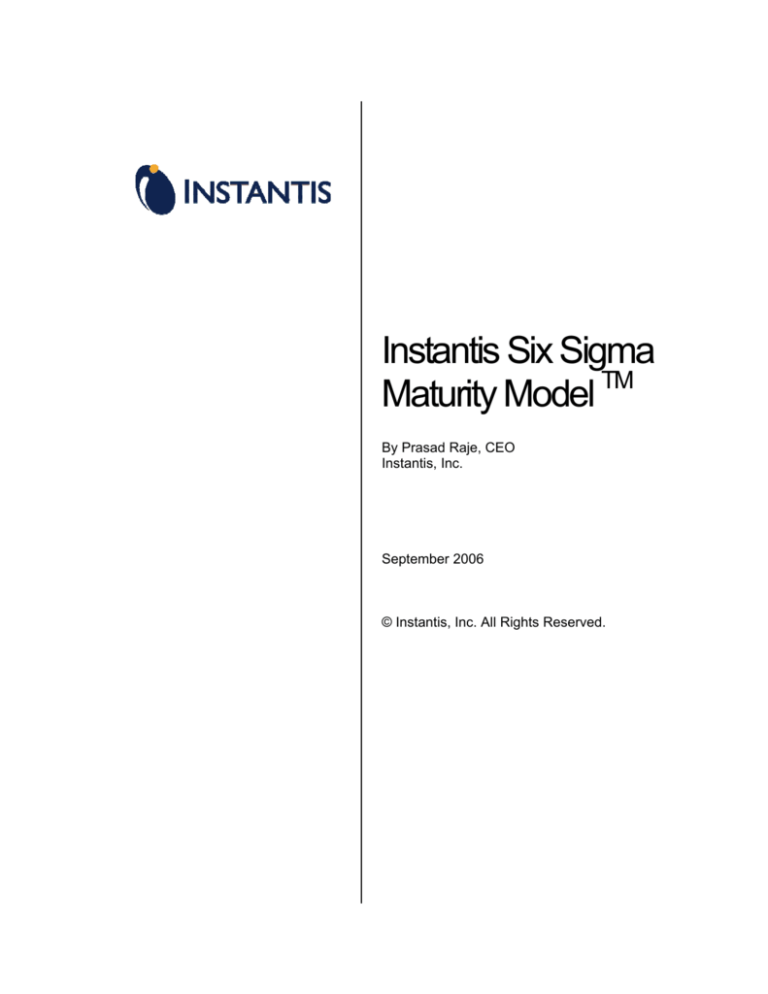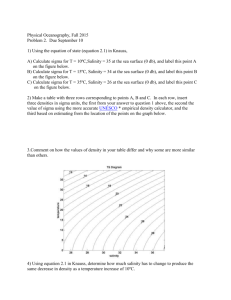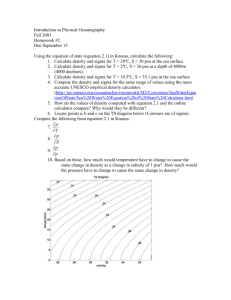
Instantis Six Sigma
TM
Maturity Model
By Prasad Raje, CEO
Instantis, Inc.
September 2006
© Instantis, Inc. All Rights Reserved.
Introduction
As organizations adopt and deploy Six Sigma, they evolve through several stages of
maturity. Until now, however, there has been no formal description of this evolution. The
Instantis Six Sigma Maturity Model™, introduced here, outlines five levels of Six Sigma
development. The intent of the model is to help Six Sigma practitioners, deployment
leaders and executives:
1. Benchmark where their companies stand in relation to broader patterns
experienced by other organizations.
2. Assess the areas of strength and performance gaps in their deployments.
3. Pinpoint specific steps they might take to close gaps and graduate to the next
stage of their Six Sigma journey.
4. Communicate progress to their Six Sigma teams and to the broader community
within their companies in order to garner additional support for their continuous
improvement efforts.
This model has been built out of the experience of working with dozens of leading Six
Sigma companies, as well as input from the Instantis Six Sigma executive advisory
board consisting of prominent consulting firms, authors and luminaries in the field.
The Instantis Six Sigma Maturity Model outlines each of the five levels along various
axes and describes the evolution of the organization along these axes as it progresses
through the levels. Time frames that organizations typically spend at each level as well.
Simple exit criteria define the transition from one level to the next. The model is
designed as a general guideline, not a prescriptive roadmap for Six Sigma
implementation.
The five levels are:
1. Launch - This is the starting point – wherein an initial few visionaries in the organization
launch Six Sigma, training is initiated and projects are begun.
2. Early Success - The initial projects are yielding results and early successes are being
achieved.
3. Scale and Replication - The early success has led to other parts of the organization buying
in to Six Sigma and a broader launch of projects is under way.
4. Institutionalization - Throughout many parts of the company, projects are yielding broadbased financial impact.
5. Culture Transformation - Six Sigma is part of the organizational DNA, financial impact is
sustained and the Six Sigma culture is pervasive – even beyond the Six Sigma practitioners and
beyond the company boundaries.
Page 2
Overview of the Instantis Six Sigma Maturity Model
Culture Transformation
Institutionalization
Culture Change
Scale Replication
Beyond DMAIC
Early Success
Reporting
Financial Impact
Project Selection
People
Training
Leadership Support
DNA of Org.
IT, New Pdt Dev
Project Roll-up
Full Closed-Loop
Excel, Stats
Project Tracking
Portfolio Mgmt
Strategy + Portfolio
Aggregate, Average
Aggregate, Average
Cross-org Comps
Ad hoc
Cost Reduction
Consistency, EP
Validation; TLG
General Ledger
Burning Platform
Low Hanging
Copy Success
Idea Pipeline
Formalized Eval
Strategy Maturing
Software
DFS, Lean
Launch
Anecdotal
Maps, Goals
Multi-Year History
Driven Few
More Believers
Career Development
Repatriated
Majority
Champion, Exec
External, BB/GB
External, Custom
Internal, eLearning
Internal, Specialty
1-2 Visionaries
Validated
Cross-Org
Expected
Ingrained
Level 1
Level 2
Level 3
Level 4
Level 5
3-9 Months
6-18 Months
24-48 Months
36+Months
12-36 Months
Level 1: Launch
Typically, Six Sigma is launched within an organization as a result of a burning platform in the
business, the arrival of a new CEO with a prior Six Sigma background, a competitive
benchmarking exercise or a bottom-up effort in a business unit. Thus, the launch can be topdown or bottom-up, but launches are generally quicker and more successful when they are topdown.
The launch usually occurs with the help of an external consulting and training firm. Consultants
typically preside over initial executive and Champion sessions designed to establish the
potential impacts of Six Sigma on business operations, revenues, costs and the company
culture. There is buy-in to start the initial training sessions to certify a core group of Black Belts
and Master Black Belts who will lead the initial projects. Organizations generally appoint a vice
president or director of Six Sigma who reports to an executive sponsor and whose charter is to
ensure a successful deployment of Six Sigma. In bottom-up launches, there may not be as
much senior executive involvement; support may only exist at a divisional level.
Table 1: The Axes of Launch
Axes
Characteristics
Leadership
Support
Initial visionaries needed to provide impetus for adoption; topdown or bottom-up
Training
Executive buy-in via external trainers; Champion training; initial
Black Belts identified and trained
People
A few driven believers, rest of the organization mostly skeptical
Project Selection
Usually a burning platform provides focus, but need to avoid
“boiling the ocean”; need to manage excessive expectations
Financial Impact
None yet, no projects completed
Reporting
None yet, no projects completed
Key Challenges: To ensure that the initial team executing the Six Sigma effort has the
necessary support in the organization, and to ensure proper project selection in order to
drive successes at the next level.
Duration and Next Level: This level typically lasts between three and nine months. An
organization moves to the next level when initial training is completed and the first set of
projects is under way, although not yet completed.
Page 4
Level 2: Early Success
At this level, the initial projects are well under way - many have been completed. Improvements
have already demonstrated significant financial and other impacts. The support that was given
to the initial team is being validated by the early results. This is a critical “show me” stage,
where it is important for the early successes to be made visible so the rest of the organization
can see the real impact from Six Sigma. This is where the ambiguity and uncertainty about the
potential business impact of Six Sigma are replaced by proven, relevant examples of business
problems faced by the company and addressed by the successful application of Six Sigma.
Table 2: The Axes of Early Success
Axes
Characteristics
Leadership
Support
The initial projects completed validate the vision of the leadership
Training
A few waves are completed, usually still external
People
Initial results are helpful; but rest of the organization is still
waiting to see if this will affect them
Project Selection
Low-hanging fruit (easy to identify projects that will yield high
impact) are plentiful
Financial Impact
Initial results are having some impact; usually focused on cost
reduction
Reporting
No consistency yet, no roll-ups because number of projects is
still small
Software
Focus is on statistical tools for the Belts
Key Challenges: To ensure that projects are completed in a reasonable time and that they
have meaningful financial impact on the business.
Duration and Next Level: Typical companies stay at this level for between six and 18 months.
A company moves to the next level of Six Sigma maturity when the initial successes have led to
the other organizations in the company beginning to adopt Six Sigma.
Level 3: Scale/Replication
At this level, the company has experienced solid success from the initial deployment and other
parts of the company are buying into Six Sigma. This is the stage at which the Six Sigma effort
scales across the company and gathers momentum. Many waves of training are in progress
across many parts of the company. Projects are being pursued at multiple organizational levels.
Table 3: The Axes of Scale/Replication
Axes
Characteristics
Leadership Support
Decision to drive Six Sigma throughout the company, leadership
across the company buys in
Training
Many waves across the company; often external trainers; content
is customized to the company
People
Six Sigma now seen as a career development path; change
agents throughout the organization see a platform that works
Project Selection
Financial Impact
Reporting
Software
Strategy Maturity
Usually replication of the patterns of success already done
(similar projects for similar problems in plants/distribution
centers, etc.)
Consistent measures of impact are in place
Enough projects completed so that average impact per project,
per Belt, etc. can be predicted; aggregate impact across the
organization is significant
Software goes beyond statistical tools to project tracking;
consistent application of methodology and financial impact
reporting is ensured
Creation of strategy maps to ensure that the mass of projects
under way are aligned with corporate and organizational
priorities
Key Challenges: To ensure that the methodology is consistently applied in other parts of the
company, and to ensure that financial impact and results are replicated. It is important to have a
strong company deployment leader who ensures consistency of methodology and results.
Duration and Next Level: The Scale/Replication level typically lasts for between one and three
years. A company goes to the next level when significant financial results have come in
throughout the various organizations in the company and significant financial impact is being
reported company-wide.
Page 6
Level 4: Institutionalization
At this level, it is not just replication of the success of another organization, but replication of the
success within each organization in the company. There is enough financial impact from
projects in each organization that meaningful comparisons can be made between organizations
on average project impact, average cycle time, total impact, etc. The Six Sigma processes have
become institutionalized throughout the company.
Table 4: The Axes of Institutionalization
Axes
Characteristics
Leadership Support
Top leadership across the business units, geographies
and divisions are all expected to be Six Sigma
supporters
Training
Very large scale; usually internalized, use of in-house
Master Black Belts as trainers; e-learning is used for
scale
People
Initial Black Belt waves have been repatriated, with
enhanced career prospects and positions in the
organization
Project Selection
Formal idea-generation/evaluation process in place to
ensure continued flow of meaningful projects; no more
low-hanging fruit
Financial Impact
Strict controls in place to ensure validation of results;
measures evolve to include revenue impact
Reporting
Comparison of results for each organizational unit is
done; aggregate corporate-wide results are reported
Software
Project tracking typically evolves to include knowledge
management and portfolio management
Strategy Maturity
Strategy maps at corporate and organizational level;
going beyond alignment, to actually launch projects to
impact the strategic goals
Beyond DMAIC
DMAIC is mastered; but DFSS, Lean, Kaizen, etc. also
are integral parts of the organization
Key Challenges: To set up consistent processes for Six Sigma execution. For example,
consistency should be achieved in areas such as project selection and scoring, approvals,
financial impact measurement and validation, project execution roadmaps, reports, Belt training,
etc. This should be pursued while allowing for controlled variation in different parts of the
company, ranging, for example, from manufacturing to transaction-heavy organizations.
Duration and Next Level: The institutionalization level can last from between two and four
years, or more. A company progress to the next level after multiple years of company-wide
adoption of Six Sigma leading to Six Sigma being embedded throughout all parts of the
company.
Page 8
Level 5: Culture Transformation
At this level, the company has had sustained success with Six Sigma for a long period. Six
Sigma is embedded in the company DNA. “Six Sigma is the way we do business” is truly
practiced. The methodologies of Six Sigma are applied not just to Six Sigma projects and by
people trained in Six Sigma, but throughout all execution processes. Six Sigma also has been
applied to the extended enterprise – customers, vendors, distribution chain and supply chain –
for mutual benefit. The culture is data-driven, process- and metrics-oriented and focused on
financial impact.
Table 5: The Axes of Culture Transformation
Axes
Characteristics
Leadership Support
Top leadership across the business units and
geographies are all expected to be supporters
Training
Very large scale; usually internalized, use of in-house
MBBs as trainers; e-learning is used for scale
People
Initial Black Belt waves have been repatriated, have
risen in career stature and position in the organization
Project Selection
Formal idea-generation/evaluation process in place to
ensure continued flow of meaningful projects; no more
low-hanging fruit
Financial Impact
Strict controls in place to ensure validation of results;
measures evolve to include revenue impact
Reporting
A results comparison is routinely done for each
organizational unit; aggregate corporate-wide results
are reported
Software
Integrated portfolio and strategy mgmt across the
enterprise; replacement of legacy with vendor apps
Strategy Maturity
Full closed-loop of strategy, to projects, to roll-up of
project results, to strategic goals
Beyond DMAIC
Six Sigma is being applied in spirit to all project
portfolios – new products, IT projects
Culture change
The entire organization operates at a higher
performance level; Six Sigma is embedded in the
culture; extends to customers, vendors, supply chain,
distribution chain.
Key Challenges: To continue to keep Six Sigma fresh and to innovate in the new areas where
it can be applied as the company inevitably goes through natural business cycles of growth,
threat, acquisitions, etc.
Duration: There is no end-point or duration at this level.
Page 10
Technology Requirements
The proper use of software technology is essential to ensure success at each level of
maturity. The following are some basic software requirements.
1. The software should provide capabilities to drive alignment between strategy and
execution so that there is a clear line of sight between project selection and results and
stated strategic imperatives and priorities.
2. The software should support robust executive-level reporting to properly roll up the
aggregate financial impact of Six Sigma on the company. For the belts, reporting should
be designed to facilitate the daily monitoring and execution of projects.
3. The software should support rich built-in reporting and dashboarding, as well as
flexible access to the raw data to enable user-defined reporting.
4. Software should ensure consistent application of the methodology and support
knowledge sharing and collaboration.
5. The software functionality should scale as the project scope grows and matures from
Level 1 to Level 5.
6. The software performance should scale from a few belts to thousands of users and
from a few projects to tens of thousands.
7. The software should be easy to use for daily routine tasks, but also be robust and
sophisticated enough to support the more complex needs of large (Level 5)
organizations.
8. The interface should be constructed so that sophisticated features stay hidden if they
are not needed, but can be enabled as the initiative matures.
9. The software architecture should be flexible to enable changes over time and enable
easy migration of old projects and data to new versions.
Instantis EnterpriseTrack
Instantis EnterpriseTrack meets these basic requirements and goes well beyond them in
order to address the needs of the largest and most sophisticated Six Sigma
deployments. EnterpriseTrack is designed to scale with the needs of organizations as
they graduate from Level 1 to Level 5. The table below lists some of the key features of
EnterpriseTrack and their relevance at each of the Levels of Six Sigma Maturity.
Level 1
Level 2
Level 3
Level 4
Level 5
Launch
Early Success
Scale
Institutionalization
Culture Change
Idea evaluation
9
9
Idea portal
9
9
9
9
9
Feature
Approval workflows
9
9
9
Charter scoring
9
9
9
Confidentiality
9
9
9
Chartering process
9
9
Integrated to Statistical tools
9
9
9
9
9
Integrated with ereference, training
9
9
9
9
9
Project Roadmaps
9
9
9
9
9
9
9
9
Tollgates
Flexible roadmaps by organization
9
9
9
9
9
9
9
9
Project Metrics
9
9
9
9
Standard financial model
9
9
9
9
Project Team definition
Flexible team by organization
9
9
9
9
9
9
9
9
9
9
9
9
9
9
Flexible data extraction
9
9
9
Searchable Knowledge base
9
9
9
9
9
9
9
9
Project replication
9
9
9
Hierarchical Strategy Maps
9
Flexible financial model
Financial approval workflows
9
Flexible financial workflows
Project level automated storyboards
9
Executive Dashboards
9
What-if scenario dashboards
Built-in reports
Document repository
9
9
Best Practices sharing
9
9
Strategy Alignment to projects
9
9
Project financial rollup to strategies
9
9
Project metrics rollup to strategies
9
Support for portfolios beyond Six Sigma
9
Page 12
Next Steps
Recommended next steps are as follows:
1.
Assess your own company’s level in the Maturity Model. You may do this internally
by benchmarking with other companies or with the help of a consulting firm.
2.
Perform a gap analysis and identify what critical “dimensions” need to progress at
your level of maturity.
3.
Communicate the findings to others in your company and get buy-in to fix the gaps.
4.
Lay out a roadmap of how your company should get to the next level and work
towards getting there.
5.
Assess your needs for software to help you on the journey.
6.
Contact Instantis for further details on the Maturity Model and how we might help
with your Six Sigma journey.
______________________________________________________________________
About the Author: Prasad Raje is the founder and CEO of Instantis, a provider of ondemand software for managing top-down initiatives to improve financial performance
and achieve operational excellence. Dr. Raje has 19 years of experience in the
technology industry, and he has led Instantis in the deployment of Six Sigma software at
dozens of leading Global 1000 companies such as Credit Suisse, McKesson and Xerox.
He has a doctorate in electrical engineering from Stanford University and is the inventor
on eight U.S. patents.






